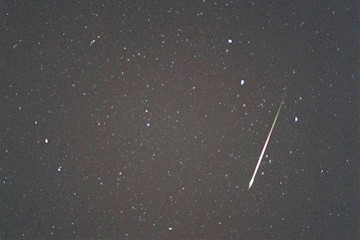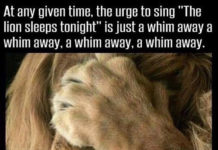

The Leonids, probably the most famous meteor shower of all, are returning to our skies! If you missed 2001’s amazing meteor storm or saw it and want more, the night of November 16 and into the predawn hours of Tuesday, Nov. 17, is the date to circle on your calendars.
The Leonid meteor shower occurs every year at this time when Earth intersects the orbit of comet Tempel-Tuttle. Each time it rounds the Sun, Tempel-Tuttle spews out a ribbon of dust that remains fairly concentrated for centuries as it follows the comet around in orbit.
The mid-November part of Earth’s orbit is littered with lots of the comet’s old dusty trails … and Earth plows through this debris zone every year. It’s like going through a minefield! Sometimes we hit a dust trail, sometimes we don’t. Usually not much happens. A typical Leonid meteor shower consists of a meager 10 to 20 shooting stars per hour. But direct hits can spark a meteor storm, which is defined as more than 1000 meteors per hour. That’s what happened in 1966 and 2001… great years for Leonids!
This year, meteor researchers are predicting the possibility that the Leonids might be back for a modest encore. Predictions call for heightened activity at about 11:30 PST and again at 1 am PST. But keep in mind that predictions of meteor rates are just that – predictions — and they can be off. The only way to be sure is to be outside watching.
Meteor showers are best seen after midnight when the spinning Earth has turned us directly into the oncoming meteor stream. By then, the constellation Leo will be rising in the east. The meteors will seem to come from a point in Leo, which gives the Leonids their name.
The hour or two before dawn should be best because the morning night sky faces the region of outer space that the Earth is moving toward. Fortunately, the Moon will be just past new on the 17th, so skies should be good and dark.
Watch right up through sunrise, since at past Leonid outbursts, brilliant fireballs have been seen in bright dawn. If you can’t watch in the early morning, it’s still possible to see meteors late Monday evening, although less will be observed. Any meteor storm will last no more than a few hours and perhaps less than one hour.
To best observe the Leonids, find a dark site with an open view of as much sky as possible. Dress warmly and get comfy in a reclining lawn chair. Give your eyes at least 10 minutes to adjust to the dark. If the skies are cloudy, don’t lose all hope. Clear breaks can still happen even under the most overcast skies. Take a nap for a while and set an alarm clock to wake you up later on. Even a small hole in the clouds near the morning peak could reveal scores of meteors.
Clear skies!



